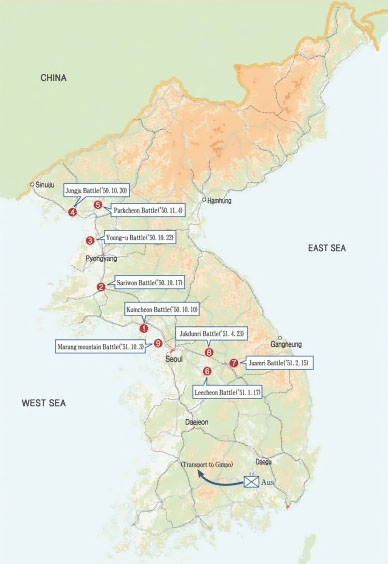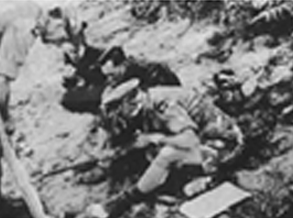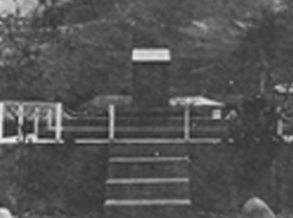Map of the major battles


Green listening to Brigade Commander
Brigadier General Coad for operation instructions
Battle of Kimhwa Jatgol (1953. 2. 26~4. 21)
This was the battle in which the Australia3rd Battalion as a member of the British 27th Brigade defeated the North Korea 239th Regiment near the Youngyu-ri area and achieved a connection with the U.S. 187th Airborne Brigade dropped at Sukcheon.
This Battalion were originally planned to be attached to the U.S. 24th Division and attack Sinanju - Jeongju after the U.S. 1st Army Corps captured Pyongyang, but they launched an airborne operation near the Sukcheon and Suncheon area following Pyongyang's capture.
When the U.S. 187th Airborne Brigade were in a great danger from the attack by the North Korean Army deployed at Youngyu-ri - Eopa-ri, this Battalion were ordered to rescue them.
This Battalion as a part of the British 27th Brigade arrived in Youngyu-ri and attacked the North Korean defense position with tank battalion's support.
It captured the enemy's position and made a connection with an airborne brigade.
The Battalion accomplished many big achievements with only little loss in this battle.
Later, this Battalion along with a British brigade continued the northward advancement
Battle of Bakceon (1950. 11. 4~6)
This was the battle in which the Australia 3rd Battalion fought with the Chinese Communist Army for the first time since participation in the Korean War.
This Battalion as a part of the British Commonwealth 27th Brigade advanced to Jeongju, north the of Cheongcheon River, on Oct. 30, 1950 following the U.N. Forces' Full Scale Offensive Plan.
But it had to retreat to Bakcheon due to the Chinese Communist Offensive, and took a defensive stand there to stop a Chinese Communist attack.
When the Chinese Communist Army occupied the British 27th Brigade's support artillery position located in the south of Bakcheon and blocked the logistics path between Bakcheon and Sinanju, this Battalion successfully carried out the rescue operation to recapture the artillery unit position and to secure the logistics path again.
This battle greatly helped the U.N. Forces secure the Cheongcheon River bridgehead during the Chinese Communist 1st Offensive.

Battalion located in Gapyung-gun Jukdun-ri
The war monument for the Australia 3rd Battalion located in Gapyung-gun Jukdun-ri
This was the battle in which the Australia 3rd Battalion attached to the British Commonwealth 27th Brigade fought with the Chinese Communist Army at Jukdun-ri, 7km north of Gapyung, for the Chinese Communist 1st Spring Offensive.
In this battle, the British Commonwealth 27th Brigade assisted the South Korean Army 6th Division retreating from the battle zone Sachang-ri because of the Chinese Communist Spring Offensive and stopped the Chinese Communist Army that was trying to block the road connecting Seoul and Chuncheon after following retreating forces to Gapyung.
The success in this battle played an important role in setting back the Chinese Communist plan to block the road between Seoul and Chuncheon from Gapyung and their 1st spring offensive.
Battle of Maryang Mt. (1951. 10. 3~8)
When the cease-fire talk began including discussion on the establishment of the cease-fire line, this battle was the operation in which the Australia 3rd Battalion attacked and captured Maryang Mt, 10km north of the Jeongok area defense line during the Commando Operation launched by the U.N. Forces to secure a favorable defense line before the establishment of the cease-fire line.
This Battalion repeatedly defeated the Chinese Communist stiff resistance and captured Maryang Mt.
The success of the Commando Operation allowed the U.N. Forces to secure the road network over Cheolwon - Yeoncheon - Seoul.
After the cease-fire agreement, the Australia Air Force was withdrawn from Korea in Oct. 1953, Naval Force in Feb. 1954 and ground troops in Mar. 1956.
